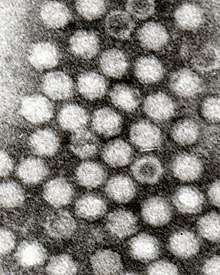|
Dependoparvovirus
Dependoparvovirus (formerly Dependovirus or Adeno-associated virus group) is a genus in the subfamily Parvovirinae of the virus family Parvoviridae;[1][2] they are Group II viruses according to the Baltimore classification. The name refers to the fact that all dependoviruses, except duck parvovirus and goose parvovirus (both classified as Anseriform dependoparvovirus 1),[3][4] cannot replicate productively in their host cell without the cell being coinfected by a helper virus such as an adenovirus, a herpesvirus, or a vaccinia virus. SpeciesThere are eleven recognized species:[5]
Virology Dependoparvoviruses have an icosahedral shape, measure 22 nm[6] and are composed of 60 wedge-shaped proteins (triangulation number = 1). Three proteins (VP1, VP2 and VP3) are present in each capsomere. Each capsid is made from 5 VP1, 5 VP2, and 50 VP3 proteins. The capsid does not have an envelope.[7] The genome is a single molecule of single stranded DNA with a length of 4.7 kilobases. It has only two open reading frames. The 3' open reading frame is the structural capsid protein, cap, which can be spliced to form two RNAs, one for virion protein 1 (VP1) and the other goes on to eventually make VP2 and VP3. The second gene, rep, can be spliced into four different, nonstructural, regulatory proteins that all aid in the genome replication. These proteins are named Rep 78, Rep68, Rep 52, and Rep 40 based on their molecular weight.[6] Due to inverted terminal repeats (ITRs) at each end of the genome, a T-shaped secondary structure is formed. The complementary areas leave a 3' hydroxyl group single stranded for the replication to begin. This 3' hydroxyl group is used as a primer for the leading strand synthesis. Both positive and negative sense strands of DNA are made. Double stranded intermediates are formed throughout the replication; this means the two strands, positive and negative sense, will be matched up.[6][7] Host rangeThese viruses are capable of replication within all vertebrates. They are only limited by the virus they must infect with, also known as the helper virus. These helper viruses are necessary for the replication of a dependoparvovirus. A common helper virus in humans is the adenovirus.[citation needed] Gene therapyReferences
External linksWikimedia Commons has media related to Dependovirus. |
||||||||||||||||||||||||||||
